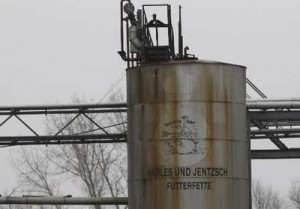
Chicken feed? Diesel fuel? At Harles und Jentzsch we make them in the same tank. Have a little dioxin with your bacon and eggs?
Another major food scare in another part of the world demonstrates anew the boundless greed and clueless lethality of industrial agriculture. Nearly 5,000 farms in Germany were ordered closed late last week because animal feeds for pigs and chickens had been contaminated with dioxin, a toxic and carcinogenic chemical. As always in such cases, the moment the crisis erupted it became apparent that 1) it had been going on for a very long time, perhaps since last March; and 2) that criminal activity may well have been involved. Yet two vital considerations are absent from the media coverage thus far.
First, what has been reported: the 4,709 farms closed, many of them pork and egg producers, had received at least 3,000 metric tons of animal feed from 25 companies, all of which had used contaminated fatty acids supplied by one plant, owned by the firm of Harles und Jentzsch. Tests of the fatty acids, which were supposed to be used in the manufacture of fuel (their use in feed may have been illegal without regard to the contamination), found dioxin at levels much higher than permitted. Almost immediately, a newspaper found test results showing elevated dioxin levels — double the amount permitted in animal feed — in the substances going back to March.
Dioxin, according to a typical news account, is “a by-product of burning rubbish and industrial activities, [that] can cause miscarriages and other health problems in humans, including cancer if consumed in high levels.”
When it was revealed that eggs from the farms using the contaminated feed had been exported to Britain, officials in both Germany and Britain assured the public that the amount of dioxin that would be present in an egg would be so small as to be harmless. (So “harmless” that five thousand farms have been locked down to prevent their delivering another egg or side of bacon until the contaminants have been disposed of?)
What is not mentioned in the usual news stories, and, coincidentally, what the industry does not want us to know (or remember), falls into two categories: the nature of the contaminant, and the nature of the animal food industry.
First, dioxin. It is among the nastiest of the products of industrial chemistry. It is a byproduct, often an accidental one, of such processes as the manufacture of pesticides, paint and paper, and exists in a special category of bad actors called persistent organic pollutants (POPs). Dioxin and its fellow POPs are typically compounds of chlorine that are not only first-tier carcinogens, but are, according to the US Environmental Protection Agency, blamed for “reproductive, developmental, behavioral, neurologic, endocrine, and immunologic adverse health effects.”
But here is the worst thing about POPs, indicated by that first word, “persistent”: they are virtually indestructible, and they bio-accumulate. Which means that the big fish that eats the little fish retains all the little fish’s POPs in its fatty tissue, and the eagle that eats the big fish gets all the POPs that all the fish eaten by the big fish were ever exposed to in their lives, and so on up the food chain. Which is why that well known POP, DDT, almost wiped out the Bald Eagle before it was stopped.
Same with people. Every molecule of every POP, Dioxin included, that you ever ingested is with you still. If you are a nursing mother, you are passing them on to your baby (and if your baby is a female, she will pass them on to her children). Thus Dioxin and the others (PCPs, furans, dieldrin, chlordane, etc.) have been accumulating in humans since the global use of synthetic chemicals began in the 1950s. As the dosage increases, generation to generation, when will it reach critical mass in individuals? No one knows, no one talks about it, and apparently no one is trying to find out.
But the people who announced that the tiny dosage of Dioxin that might be in their tainted eggs is harmless, knew, or should have known, that they were lying.
The second thing not mentioned in the news accounts was the source of the “fatty acids.” This undoubtedly refers to the product obtained by rendering animal carcasses. The feeding of fatty acids to animals evolved to eat grass and bugs amounts to forced cannibalism. There are really good reasons for the ancient taboos: cannibalism is the source — and the sole source — of the spread of mad cow disease, for example. And their use in synthetic feed compounds is always, inevitably, fraught with peril.
The German farms will reopen shortly, and the British egg eaters will be reassured that their quiche is perfectly safe. It will be back to business as usual, which should make us all afraid — really, afraid.